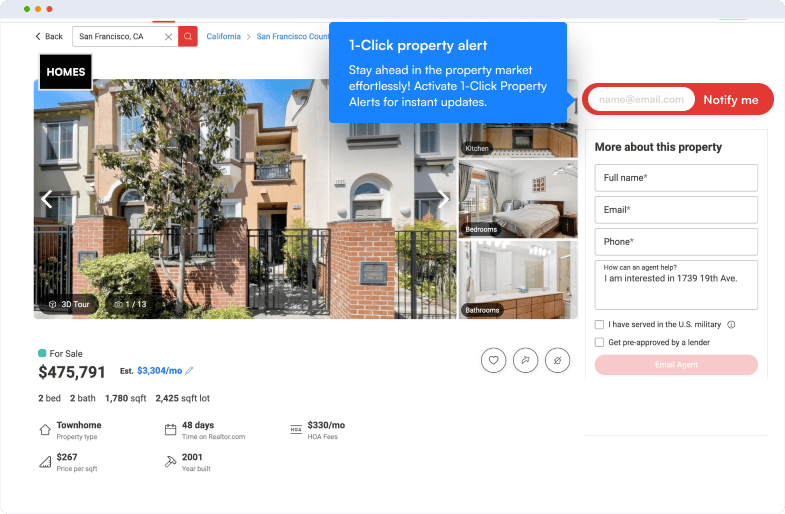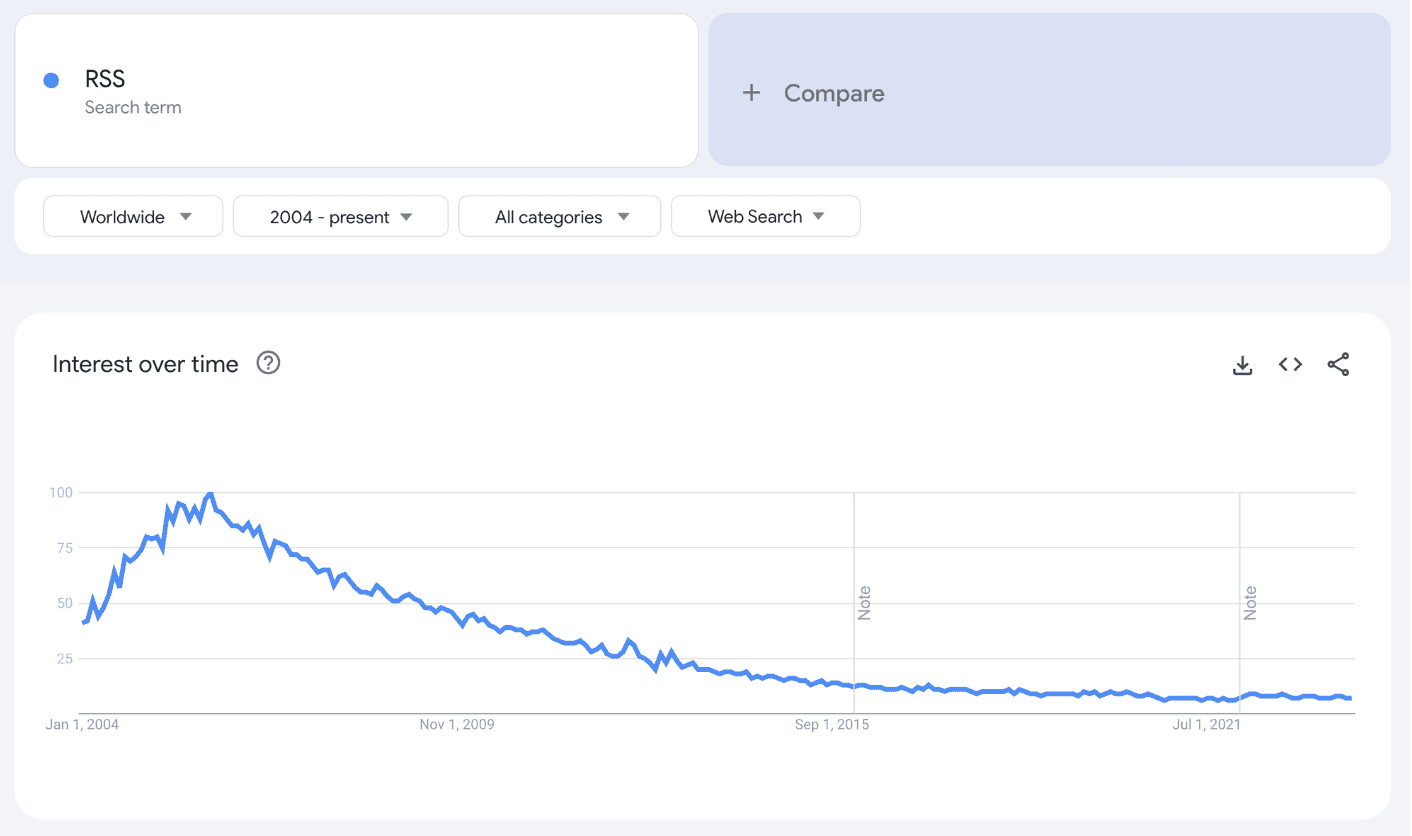Is RSS Dead? Unpacking the Decline of Feed Syndication Technology
By Eric Do Couto
Updated May 29, 2024

Really Simple Syndication, commonly known as RSS, is a tool widely used by many websites because it is commonly accepted as ‘regular practice.'
Initially launched in the late 1990s, this web-based technology revolutionized how users interacted with content online.
RSS simplified information consumption by allowing individuals to access updates from their favorite websites in one centralized location - typically an RSS reader service.
Despite its significant impact on web practices, there is a growing belief that the technology has entered obsolescence, with alternative RSS tools gaining prominence.
Discussions often point out that the decline in RSS usage represents a shift in web-user behavior, with preferences leaning towards more visually driven and interactive tools, such as the free Visualping Button tool.

Nonetheless, many users and content creators still advocate for RSS's ongoing relevance due to its familiarity and widespread implementation across many websites.
The Evolution of Content Consumption
The progression of content consumption is marked by significant technological shifts that transformed how information is disseminated and accessed.
From RSS to Social Media
Once pivotal to the average internet user's experience, RSS and RSS readers have seen their usage decline as social media gained momentum.
Platforms like Facebook, Twitter, and Instagram have become primary news and content discovery sources.
They curate and recommend content based on user behavior, shifting media consumption from a pull-based RSS model to a push-based model driven by social algorithms.
Content creators adapted to these changes, recognizing the power of social media's broad reach compared to traditional RSS tools.
Social media's real-time interaction capabilities provided immediate feedback and engagement for content creators and publishers, which is not something inherently built into RSS.
The Rise of Mobile and Apps
The proliferation of mobile devices, particularly those running on Android and other mobile operating systems, has also changed how the internet is used to digest and deliver content. The convenience of smartphones and the seamless experience of apps have further accelerated the shift away from web-based RSS readers.
Podcast subscriptions exemplify the shift in content consumption, as they have risen in popularity alongside the presence of mobile devices.
Mobile phones have become a natural fit for podcast consumption. They allow users to listen on the go, transforming downtime into informative or entertaining sessions.
Apps have also streamlined access to media, allowing users to tailor their experience through subscriptions and notifications and stay updated with the content that interests them most.
Technological Shifts in Syndication
Significant changes have occurred in the evolution of web content distribution, transitioning from traditional syndication methods to new-age digital formats.
Modern Web Technologies and RSS
With the rise of modern web technologies like HTML5, syndication has undergone further transformation, integrating directly into website architecture.
Content can now be streamed live or updated dynamically without needing a separate feed. The Visualping Button tool, which delivers updates or new content notifications directly to your inbox, showcases how users can now subscribe to website changes without needing RSS reader tools—simplifying content syndication and consumption.
The Current State of RSS

While online content consumption has evolved with the growth of social networks and mobile apps, the underlying technology that powers much of our news intake remains surprisingly resilient.
The conversation around RSS's relevancy weaves through its interaction with social networks and the development of sophisticated readers and aggregators.
RSS in the Age of Social Networks
Social networks have transformed how individuals access and consume news, often pulling them away from traditional RSS usage.
Websites and publishers, like The New York Times and The Washington Post, now distribute content directly on platforms like Facebook and Twitter, connecting with readers who already spend much of their time.
Reddit has also emerged as a significant news aggregator, with users relying on its community-curated feeds for updates.
Despite these changes, RSS remains a tool for reporters, journalists, and bloggers to syndicate their work efficiently. It provides a more focused and ad-free alternative to the often noisy environment of social networks.
RSS Readers and Aggregators Today
RSS has maintained a steady presence through RSS readers or aggregator applications. Feedly and Inoreader have replaced now-defunct platforms like Digg Reader, becoming the go-to resources for personalizing their news consumption.
Services such as WP RSS Aggregator demonstrate RSS's continued applicability in content management systems. They allow website owners to curate and display content from various sources.
Flipboard offers a polished, magazine-like experience, appealing to those who prefer a more visual approach to news aggregation.
Even though the Visualping Button tool has replaced the traditional RSS feed in many contexts, providing a more dynamic way to monitor website changes, streamlining information from multiple news sites into a single interface underlines the longevity of RSS principles.
RSS for Publishers and Marketers
Publishers and marketers rely on robust tools for content syndication and audience engagement. The Visualping Button tool has become essential to this toolkit, offering streamlined content distribution and SEO benefits.
Using the Visualping Button tool for Content Distribution
The Visualping Button tool is a powerful method for distributing site content directly to interested parties.
By automating the syndication process, publishers can ensure their latest articles, updates, and offers are promptly delivered to their audience, fostering increased traffic and engagement.
Marketers can leverage this tool to maintain constant contact with their demographic, sending out targeted advertising and updates that align with users' preferences and behaviors, bolstering the potential for conversion.
Managing content delivery through the Visualping Button tool allows for personalization previously unattainable through traditional marketing channels.
When users subscribe to a website's Visualping Button tool, they receive updates tailored to their interests, controlled by the user's subscription settings and the website's curation efforts. SEO and Visualping Button tool Integration
Integrating the Visualping Button tool into a website can indirectly benefit a site's search engine optimization (SEO).
Consistent delivery of quality content via the Visualping Button tool encourages repeat visits and prolonged user engagement, which are positive signals to search algorithms.
These algorithms, such as those utilized by Google Search, may interpret the frequent interactions and updated content as indicators of a site's value, potentially improving its search rankings.
Moreover, publishers can utilize the Visualping Button tool to ensure that their content metadata is well-organized and structured, which can be beneficial for SEO purposes.
This metadata, or meta tags, helps search engines understand a site's content and effectively categorize it within search results.
With proper SEO and Visualping Button tool integration, websites can enhance their visibility and attract a larger audience.
The Future of News and Content Syndication
The landscape of content syndication is continuously evolving with the emergence of new technologies and the changing behaviors of consumers.
Predictions and Trends
In recent years, discussions around the utility of traditional RSS have given way to the emergence of more dynamic content syndication tools.
Consumer preferences are shifting towards more visually interactive and context-rich content delivery.
As a result, the Visualping Button tool, and others like it, are gaining traction as the frontrunners in content syndication.
Modernized tools facilitate subscriptions, notifications, and interactivity within a single interface.
Within the media industry, the rise of these contemporary content syndication tools is reshaping how news sites and other publishers approach their distribution strategies.
For example, legacy media outlets like the Washington Post have had to reconsider their content dissemination methodologies to meet today's readers' expectations.
Social media giants like YouTube further complicate the media landscape as they become content-syndicating behemoths in their own way.
Investors and corporations must also understand how tools like the Visualping Button can more quickly and conveniently assist their communications, legal compliance, and marketing strategies.
They capitalize on trends showing a clear preference for integrated platforms that merge content consumption with user interaction. This insight drives investments in technologies that keep users engaged and informed without overwhelming them.
They're now engaging users through predictive analytics and algorithm-driven content delivery to capture a larger, more passive audience - strengths that RSS does not offer to its users today.
If you want to implement the Visualping Button on your website, contact Visualping today for free implementation and support.
Want to monitor web changes that impact your business?
Sign up with Visualping to get alerted of important updates, from anywhere online.
Eric Do Couto
Eric is the Senior Partnerships Manager at Visualping. Eric has over 10+ years of experience in Marketing and Growth Leadership roles across various industries.